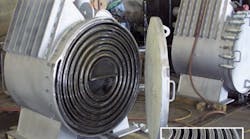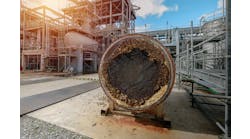This Month's Puzzler
We design anaerobic digester systems for clients who use the generated methane for power. In addition, we operate some facilities. Our design relies on spiral heat exchangers that have a solution of 50% propylene glycol and water (PG/aq.) on one side and sludge or manure on the other side. The manure is heated to 110°F by PG/aq. at 185°F–160°F.
We’re suffering a lot of problems with our design, especially the heat exchanger loop (see figure). One problem is poor heat transfer because some manure has migrated to the glycol side; this also is a safety issue because the glycol system is closed. In addition, we’re under scrutiny by the U.S. Environmental Protection Agency because of hydrogen sulfide emissions.
The people in our operations group are certain the culprit is poor welding in the exchangers; they can’t see how leaks can be detected in the spiral exchangers. So, they have persuaded management to switch to a shell-and-tube exchanger with one shell pass (manure) and two tube passes (glycol solution). I’m not convinced about the design and don’t think operations has proved their point — what do you think? Is that shell-and-tube exchanger a better choice than the spiral?
Figure 1. Respondent recommends unit that has channels without spacers.
Switch To Shell-And-Tube
I see that you have a problem but you only gave us half the story. We have no details of the sludge side of your process other than temperature. Your flowsheet shows exchanger outlet pressures of about 10 psig on the glycol side.
Spiral heat exchangers are great for providing large exchange surface at minimal cost. They work well so long as the differential pressure across the heat transfer surface is fairly low and neither side is prone to fouling.
[callToAction ]
My preference is for shell-and-tube heat exchangers when one of the fluids is a slurry. However, without a compelling reason not to, my designs put the slurry inside the tubes. It is much easier to clean the inside of a tube than the outside.
All this being said, there is a simple trick that I used in the 1970s to prevent leakage between a glycol heat transfer fluid and a process fluid. Our issue was keeping the glycol out of the process side, so we kept the process pressure higher than the glycol side. In your case, you should keep the glycol pressure higher than the process pressure, assuming of course that the presence of glycol doesn’t adversely affect your digester operation.
Vic Justes, consultant
St. Augustine, Fla.
Stay With Spirals
I believe that a spiral exchanger still should be your solution. The design needs to have welded end construction (for glycol solution side) and channel spacing without spacers. This design should provide excellent heat transfer and anti-fouling characteristics. It also eliminates cross contamination while providing excellent cleanability should fouling occur (opening of both ends and easily high-pressure blasting through the unit). If your unit is not of this design, you should get a replacement unit that is; I do not believe modifications would be viable or cost effective.
Jim Bliss, maintenance/utility engineer
Occidental Chemical Corp., Niagara Falls, N.Y.
Monitor For Leaks
Detecting leaks is relatively easy in closed system because the offending chemical doesn’t dissipate. However, detection can be tough if the chemical reacts with the circulating fluid.
Some H2S monitors can work well with an aqueous stream. I suggest having operators use lead acetate test strips weekly. These strips can detect H2S concentrations down to 5 ppm-m. Take precautions by using an enclosed plexiglass sampler.
It’s important to catch H2S as quickly as possible, especially in a closed system. H2S is a reducing agent (electrophile) and is flammable. Note in particular that H2S, if present, in the PG/aq. solution will react with aldehydes (violently) and dioxalanes.
Corrosion occurring in the spiral heat exchangers most likely will appear first at the welds. I suggest cutting up one of your leaky exchangers and dye-testing the welds. Changing heat exchanger type won’t make the problem go away. Switching to shell-and-tube exchangers might even make the problem worse because they are more complex that spiral units.
One common solution to leaks is to de-pressurize the most offensive chemical. Why not lower the pressure on the manure side or raise the pressure on the PG/aq. side?
You can handle the odor complaints in a number of ways, including by planting vegetation that will mask the odor with a pleasant scent or absorb the odor. Another option is using a fogger to spray a fine mist over the area where the odor is produced; a mild carbonate solution or even water should suffice to eliminate much of the foul smell.
Dirk Willard, consultant
Wooster, Ohio
Figure 2. Poor temperature control afflicts the reboiler.
September’s Puzzler
We’re having trouble controlling the reboiler in the regeneration column for diethylamine (DEA) — see Figure 2— at a refinery we recently bought. The DEA concentration is about 35% by weight. The tower pressure varies 2–3 psig from design. Originally, this DEA process fed our refinery sulfur recovery unit (SRU); as of the last turnaround, it only polishes the gas before the SRU. This system hasn’t been stable since startup.
This tower was built many years before modern simulations existed; plant records lack details about any models used for the column.
Should we move the feed tray, change the feed conditions, or reposition the controlling thermocouple further up the column? Would raising the condenser recycle ratio help? Can we alter the amine or the concentration to get better results? What else should we consider?
Send us your comments, suggestions or solutions for this question by August 11, 2017. We’ll include as many of them as possible in the September 2017 issue and all on ChemicalProcessing.com. Send visuals — a sketch is fine. E-mail us at [email protected] or mail to Process Puzzler, Chemical Processing, 1501 E. Woodfield Rd., Suite 400N, Schaumburg, IL 60173. Fax: (630) 467-1120. Please include your name, title, location and company affiliation in the response.
And, of course, if you have a process problem you’d like to pose to our readers, send it along and we’ll be pleased to consider it for publication.


